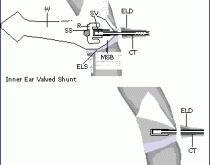Inner Ear Shunt

The Inner Ear Valved Shunt helps regulate endolymph pressure and establishes a conduit for excessive flow from the endolymphatic system under pressure to the mastoid cavity. By helping maintain endolymph volume and pressure at normal physiologic levels, the Inner Ear Valved Shunt helps facilitate cochlear recovery and provides the best chance of substantial hearing gains, in addition to its excellent success rate for complete elimination or substantial control of vertigo.
Both hearing improvements and vertigo control have been more frequent for patients when the shunt is implanted compared to other endolymphatic sac surgical methods. The shunt is implanted in the endolymphatic duct which is approached through a mastoidectomy using microsurgery techniques. Identification and cannulation can be a routine procedure when specialty inner ear microsurgery methods and instruments are employed. The EA–1001 is M.R.I. compatible. Methods have been developed for inner ear surgery and shunt implantation that have resulted in very low morbidity with most patients returning from the hospital in less than 24 hours.
- Low morbidity of surgery
- 24 hour hospitalization for most patients
Huang Inner Ear Shunt
The Huang Inner Ear Shunt is similar in design to the Inner Ear Valved Shunt. In order to be a simple alternative, the Huang device does not include the valve. Procedures for implantation are similar and the specific instruments are available from Hood Laboratories. The Huang Inner Ear Shunt consists of a chamber, an open ended lumen, and a sponge to protect the lumen from tissue ingrowth.
Hood Endolymphatic Shunt Tube
The Hood Endolymphatic Shunt Tube (ELS Shunt) is a conservative alternative device used for endolymphatic sac surgery (ELS). This basic device consists of a catheter tube (CT), connected to a silicone tube.
* T. Huang, M.D., Chang Gung Memorial Hospital, Tapei, Taiwan R.O.C.
share